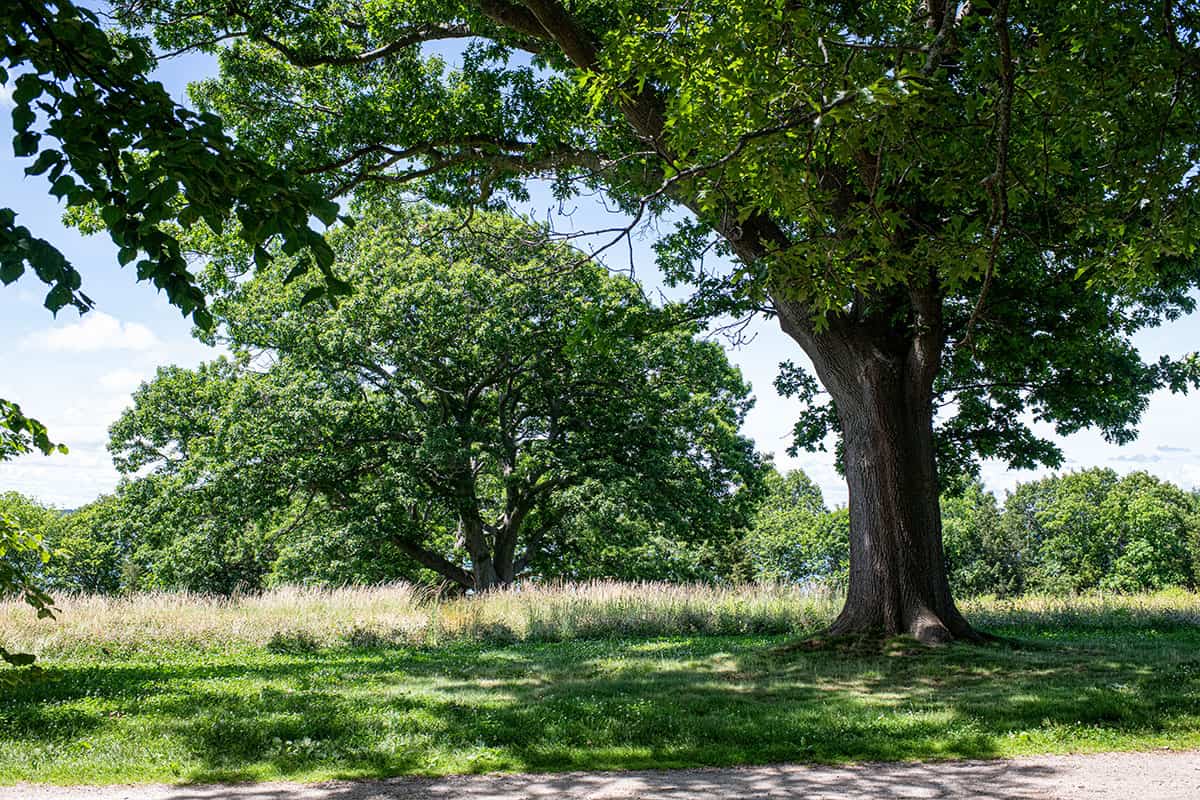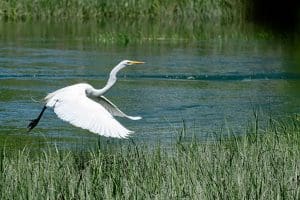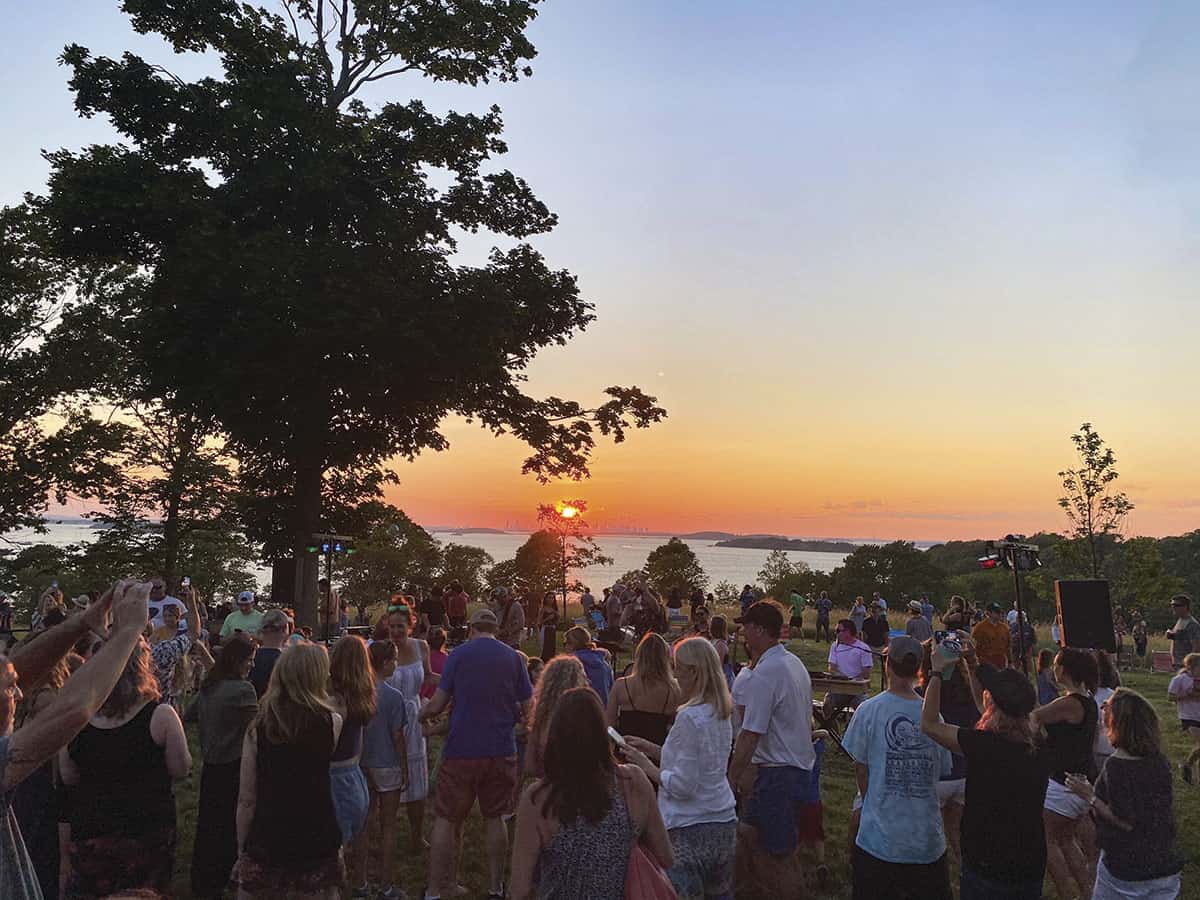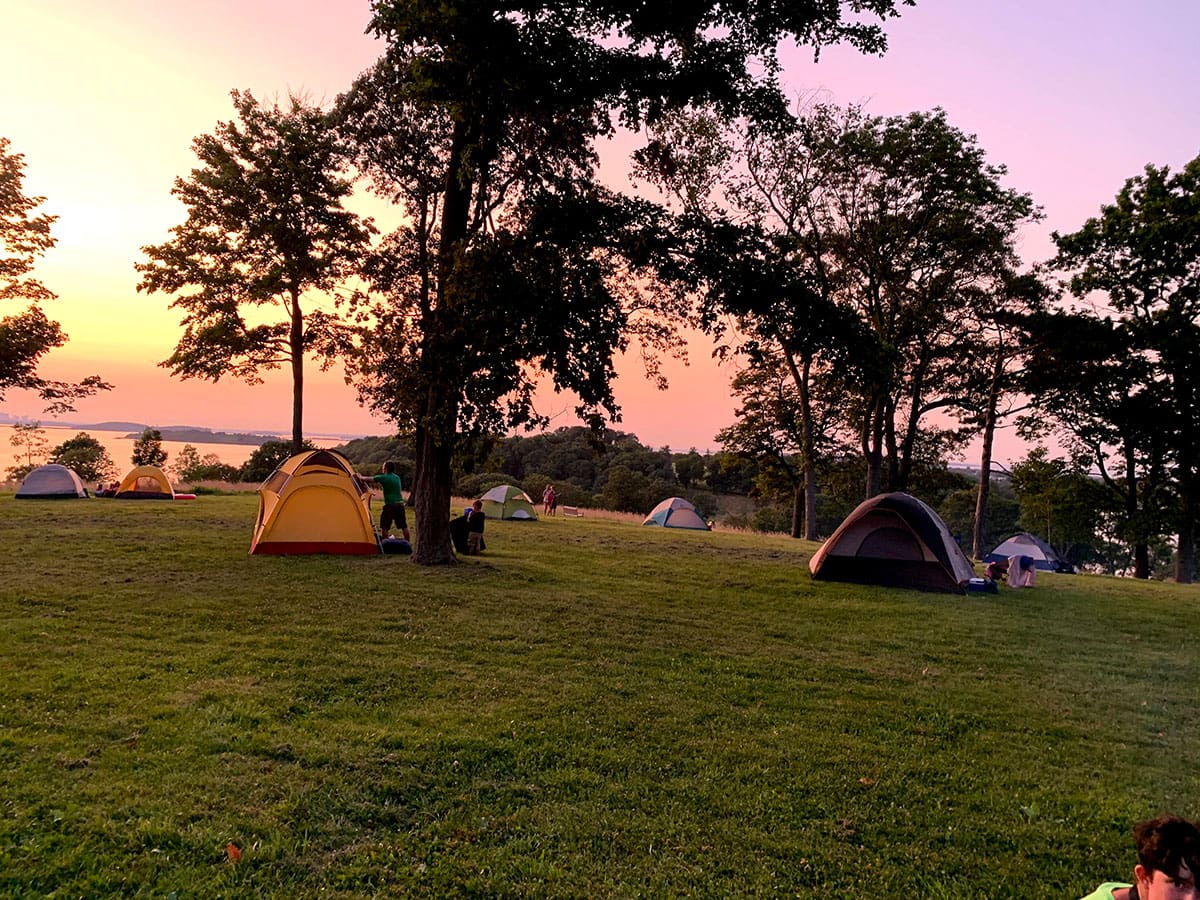Exploring the history and highlights of Hingham’s beloved natural refuge.
By Jennifer H. McInerney
Photography by
Jack Foley and Trustees of Reservations
As far back as colonial times, the 251-acre expanse of undeveloped land that juts out between Hingham and Hull Bay has been fittingly referred to as World’s End. Situated at the back of a wooded residential neighborhood that hugs the town’s coastline, World’s End encompasses four drumlins described as “spoon-shaped hills formed by glaciers” that spread forth and eventually spill out into the Atlantic Ocean. Rocky shoreline, open fields, forests, thickets, and grand lanes all coexist in this singular landscape, which culminates at its highest elevation with unsurpassed views of the Boston skyline, Hull, and beyond.
The Trustees of Reservations, a Massachusetts-based member-supported organization that protects and preserves 120 properties statewide, including World’s End, has no specific records detailing the origin story of the name behind this exceptional site.
“World’s End is a double peninsula that was, effectively, off the cultural map for early colonists,” says Alison Bassett, manager of the Trustees Archives and Research Center and a champion of Trustees Trivia. “No roads went through it to some other town. No house stood on it. No newsworthy event took place there. World’s End was just what its name suggested: an out-of-the-way spot.”
Fortunately for local residents, this precious parcel of land has been rescued multiple times from development and preserved in perpetuity as an everlasting sanctuary.

Olmsted—and What Almost Wasn’t
While standing atop Planters Hill, the highest point at World’s End, and gazing beyond the rolling hills out toward the Boston Harbor Islands, it’s hard to imagine that this undisturbed natural setting nearly became a 163-home residential subdivision.
John Brewer, who built a mansion for his family at World’s End in 1856, proceeded to acquire most of the peninsula’s acreage over the ensuing three decades. In 1890, he sought the services of well-known landscape architect Frederick Law Olmsted, whose legacies include New York City’s Central Park and Boston’s Emerald Necklace Conservancy of interconnected parks. As requested, Olmsted presented a proposal to subdivide the World’s End property, but the plan never fully came to fruition.
“One story is that John Brewer never intended to build the subdivision,” says Anne Smith-White, portfolio director of seven Trustees properties in the South Shore region, including World’s End.
A rendering of the subdivision plan Olmsted designed for World’s End hangs in Smith-White’s Hingham office. “He had Olmsted draw up the plan and design the carriage roads and tree plantings. Brewer and his sons cut the paths and planted the trees, but they didn’t go any further with the plan.”
Two later proposals—a United Nations Headquarters in the 1940s, and a nuclear power plant in the 1960s—also never came to pass. In 1967, concerned neighbors Sam Wakeman and Tom O’Donnell spearheaded a fundraising campaign and joined forces with The Trustees to purchase the property and prevent future proposals from being considered. This summer, World’s End will open the doors to its brand-new Wakeman & O’Donnell Education Building, in their honor.
The Lasting Landscape
In the early months of the COVID-19 pandemic, World’s End became a more popular destination than ever, as people sought a safe, open-air, socially distanced alternative to sitting at home. Visits to the reservation increased by 214 percent, according to Trustees records, prompting the organization to implement timed ticketing entry—a practice that continues—to ensure parking availability and minimal disturbance to the neighborhood.
With its wide-open spaces and breathtaking vistas, “World’s End has become a place of solace for a lot of people,” says Smith-White. The options and opportunities for exploration are also wide-open, and have been expanded over the past two years to include guided bird walks, moonlit tours, off-the-beaten-path excursions, and more (see sidebar).
The Trustees continue their dedication to preserving and prolonging the natural wonders of World’s End with a multipronged approach to habitat restoration. The oldest trees still standing at World’s End are known as The Seven Oaks—though only six remain. The Brewer family planted these oaks 200 to 250 years ago to serve as a dividing line between their fields. About 15 years ago, the seventh tree fell victim to a lightning strike, reports Wayne Ciullo, Stewardship Manager for the South Shore Trustees sites, including World’s End.
Most of the other original and native plantings from the Brewers’ days have died off, due to disease, erosion, climate change, and the inevitable passage of time. But, thanks to the ongoing efforts of the Trustees, visitors to World’s End do not encounter a devastated wasteland. Quite the contrary: the biodiversity here is highly rated by the National Parks Survey. World’s End teems with a growing, thriving landscape that’s being continually protected and renewed with more resilient species that are better suited to weather the northeast climate. As an example, Ciullo points to Norway maples, whose brittle nature is susceptible to breakage. Planted in their place are sweet gum, hardwood trees that have leaves similar in shape to maples and produce brilliant red foliage in the fall; in addition, their pods provide food sources for native wildlife.
“World’s End is known for its varied mosaic of habitats,” says Ciullo.
Perhaps one of the most unique habitats is the Maritime Juniper Forest, located in the Rocky Neck coastal area at World’s End, which is home to a species of butterfly called the Juniper Hairstreak, also known as Olive Hairstreak for its green-hued wings.
“We have a stable population of Juniper Hairstreak, which live only in maritime juniper forests like the one on Rocky Neck. This habitat is fairly rare in New England,” says Ciullo. “It’s a transitional ecosystem that we’re trying to preserve by removing invasive tree and plant species.”
To promote healthy ecosystems throughout the entirety of World’s End, the Trustees have embarked on a multi-year Pollinator Habitat Enhancement Plan, developed with the Trustees’ ecology team and the National Resource Conservation Service (NRCS). The goal is to gradually remove and reduce invasive plant species and replace them with pollinator-friendly plants, such as goldenrod, trefoil, clover and other wildflowers.
“Over time, visitors may notice an increase in the number of wildflowers and a decrease in encroaching vines.”
Taking a Walk on the Wild Side at World’s End
Depending on the time of day, the season, the temperature and weather conditions, every visit to World’s End will be different and memorable in its own way. Whether wandering and meandering or trekking purposefully, the range of elevations and types of terrain offer endless possibilities.
Upon entering the property and crossing over the bridge, visitors can veer right onto the Barnes Road carriage path, past the Damde Meadows, or continue straight ahead up Planters Hill—to admire the sweeping views—via the Planters Hill Loop or the Brewer Road path. Heading in an easterly direction toward the Weir River eventually leads out to Rocky Neck—home to the Juniper Hairstreak butterflies and a trove of coastal treasures. Descending the other side of Planters Hill leads to “The Bar,” a stretch of land that connects the double peninsula and the outermost portion of World’s End.
And if the array of carriage paths, wooded trails, rocky shoreline, open fields and hills overlooking the ocean and beyond ever lose their luster, the Trustees also offer specialized outings for adventure seekers year-round.
In Search of Feathered Friends
Among its abundant charms, World’s End boasts superb bird-watching opportunities. Its diverse habitats, from thickets to tidal mudflats, attract an assortment of bird species—both local and migrating.
Over the past 15 years of record-keeping, avid birder Sally Avery has sighted 143 different species of birds at World’s End. In early 2021, the Trustees enlisted Avery’s expertise and guidance to lead bird-watching outings at World’s End. Offered on a monthly basis, these guided excursions are always fully booked. “Winter weather is not a deterrent for birders,” Avery adds. “Every time you go birding, you never know what you’ll see.”
As an example, Avery cites a weekend in mid-February, when the temperatures soared into the 60s and, suddenly, “There were bluebirds everywhere. The snow was melting, so the bluebirds were out looking for insects.” Normally, at that time of year, the most prevalent birds are the year-round residents: titmice, chickadees, cardinals, nuthatches, woodpeckers and ducks.
As one might expect, bird sightings change with the seasons. In the spring, World’s End is the place to go to see warblers—some 30 different species of warblers. “These are 4- to 5-inch birds in shades of yellow, black, white and a touch of red,” Avery describes. “It’s really something to see them all at once.” Warblers have made an annual habit of stopping at World’s End each spring on their way to Canada, to breed in the Boreal Forest.
 Summertime brings red-winged blackbirds by the hundreds to World’s End, according to Avery. “The sight of these black birds with their bright-red epaulets really surprises people.” And just as impressive are the multitude of bobolinks, a relative of blackbirds and orioles which birders often describe as “wearing a tuxedo backward.”
Summertime brings red-winged blackbirds by the hundreds to World’s End, according to Avery. “The sight of these black birds with their bright-red epaulets really surprises people.” And just as impressive are the multitude of bobolinks, a relative of blackbirds and orioles which birders often describe as “wearing a tuxedo backward.”
For birders hoping to spot a rarity, autumn presents the most likely prospect, as birds migrate south for the winter. “In the fall,” Avery explains, “birds aren’t in as much of a hurry as they are in the spring, when they’re migrating north to claim their breeding territory. So the fall is a protracted migration period; plus, hurricane season can sometimes throw unexpected birds off their intended paths.”
In the fall of 2000, a few months after Avery took up birding seriously, she had a record-breaking sighting at World’s End: a Tropical Kingbird, the first of its kind ever identified in Massachusetts. These large yellow-and-gray flycatchers are popular in Middle and South America and are regular fall visitors to the Pacific Northwest—not typically the Northeast. Needless to say, Avery’s unusual find had birders from all over “flocking” to World’s End during the Tropical Kingbird’s one-month stay.
Now, as part of the monthly Bird Walks at World’s End, Avery takes birders to “The Valley,” located on the farthest-reaching drumlin, one of two areas on the reservation featuring untouched thickets, a favorable habitat for migrating birds. “As World’s End is one of the few undeveloped properties along the coastline, birds like to stop here along their migration routes,” says Avery.
For prime viewing of shore birds and wading birds, including egrets, heron and osprey, she brings birdwatchers to the bird blind at “Bird Alley,” overlooking Damde Meadows. “There have also been lots of sightings of bald eagles in the last year,” says Avery.
Recently, on the west side of World’s End, looking out toward Hingham Harbor and Martin’s Cove, the birding group has glimpsed great egrets, black-crowned night herons, and oystercatchers. Registration is required for bird walks at World’s End and space is limited.
By the Light of the Full Moon
Only a fortunate few have enjoyed the rare privilege of viewing World’s End under the full moon’s glow. Each month, when the moon grows to its roundest shape and fullest size, Trustees Educator Robin Steele sets off at dusk with an intrepid group on a Moonlight Hike at World’s End. After hours, the reservation’s gates are closed to all but those who’ve registered for the Moonlight Hike.
“This is a unique opportunity to see World’s End at a time of day when most people don’t get to see it,” Steele remarks. “Most people have never seen the sunset or the moonrise over World’s End.”
Moonlight Hikers ascend Planters Hill as the sun makes its descent, turning the sky several shades of orange and pink as the sunset hovers over the Boston skyline to the west.
“When we get to the top of the hill, there’s always a lot of oohing and ahhing as people take in the view,” she says.
A few minutes later, as the sun disappears, Steele directs participants in an easterly direction, where the full moon has begun to make its presence known amid the darkening sky. Facing the wind turbine and the Hull coastline, the group climbs slowly down the drumlin for a closer view of the rising moon.
“As we descend, we keep an eye out for crepuscular wildlife—animals that are active at twilight—such as white-tailed deer, red fox, raccoons and skunks,” says Steele. “We also discuss the significance of that particular month’s moon—the Wolf Moon in January, the Snow Moon in February, the Worm Moon in March, and so on.”
Continuing down the hill, the group pauses for a few moments in the cedar grove between the carriage path and the Damde Meadows to admire the moon’s reflection sparkling on the water. Then they veer left on a shortcut that takes them through woodlands to the Bird Blind, surrounded by tidal mudflats and the “ghost trees” that did not survive the opening of the dam decades ago.
“With the moon so bright in the sky and illuminating the ghost trees, it’s quite a mood,” Steele observes.
In the wintertime, when the days are shorter, the Moonlight Hikes begin as early as 5 p.m., but as summer approaches, the start times can be as late as 8 or 8:30 p.m.
“Each month’s full moon is special in its own way, but the Supermoons tend to be the most dramatic and exciting,” Steele notes. “When the moon is closer to the earth, it looks bigger, like you can reach out and touch it.”
Registration is required for Moonlight Hikes at World’s End and space is limited.

Celebrating Summer
Since 1984, World’s End has heralded the arrival of summer with an annual Summer Solstice celebration. The event welcomes a limited number of registered guests to drive their cars across the bridge and park in the field for an evening of food, beer and ice cream trucks and entertainment by the Aldous Collins Band.
“People play lawn games and frisbee and there are kids running around. It’s such a beautiful community gathering,” says Smith-Gillen.
Don’t miss the Summer Send-Off that will take place at World’s End on August 27. Gather your friends and family to celebrate the end of another beautiful season. Sit atop Planters Hill and enjoy live music, great food and craft brews, and an incredible sunset over the Boston skyline. Entertainment will be provided by Duppy Conquerors, a Bob Marley tribute band. (check their website for details). Pre-registration is required. No tickets will be sold onsite.
World’s End Walks for Every Pace
In addition to Bird Walks and Moonlight Hikes, the Trustees offer excursions designed to appeal to different interests and activity levels:
Off the Beaten Path: for more adventurous hikers and families, these guided outings venture off the oft-traveled carriage paths and woodland trails, including Rocky Neck to explore the shoreline and juniper maritime forest.
Mindfulness Walks: these guided meditative walks make the most of the natural serenity of World’s End, inviting participants to relieve stress while reconnecting with nature.
Women’s Walks: occurring at World’s End as well as other Trustees properties statewide, these walks encourage women to come together as a community, enjoying the safety of walking trails together in a comfortable and supportive environment.
Natural History Walks: these family-friendly excursions focus on different themes in nature, such as the spring equinox/signs of spring, tree tours, insect investigations, geology explorations, and more.
Each of these walks will convene at the new Wakeman O’Donnell Center, near the entrance to World’s End. Registration is required.

Campouts and Summer Camps
Imagine pitching a tent under the stars atop a glacier-formed drumlin at World’s End! In July and August, a limited number of registered campers will have the opportunity to set up camp, picnic in the great outdoors, toast marshmallows and tell stories around the campfire.
“This is a special opportunity to camp out overnight at World’s End,” points out Elyssa Scheck, Engagement Manager for the reservation.
For youngsters who’d like to explore World’s End by day, summer camps are offered in one-week sessions from late June to mid-August.
“Each week features different activities and adventures,” reports Jasmine Smith-Gillen, Education Manager and Camp Director at World’s End. Guided by rangers and educators in the field, activities include exploring the natural landscape; searching for snails, crabs and other marine life; building forts and fairy houses; educational games; bird-watching at the bird blind; crafts, reading and more. Early registration is recommended.
For more information about World’s End or to register for an event, visit thetrustees.org.
